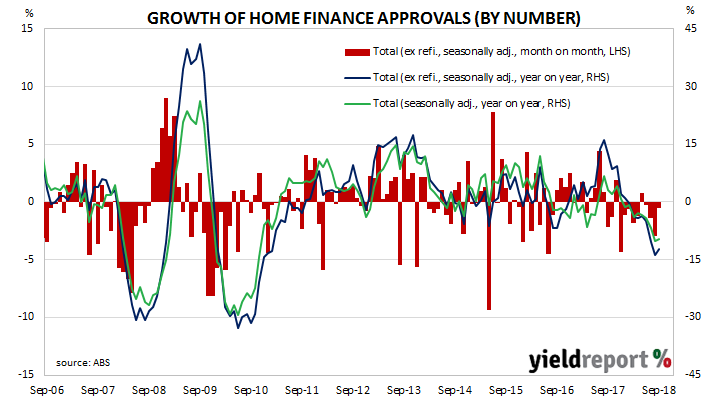The Australian Bureau of Statistics (ABS) collects data on housing finance commitments made by significant lenders and their figures include secured (mortgage) finance commitments for the construction or purchase of owner-occupied dwellings and investment properties. It has some overlap with the RBA’s monthly private sector credit statistics which also includes investor lending and owner-occupier lending.
The ABS has released housing finance figures for September and they were in line with expectations. Total approvals fell by 1.0%, down from August’s -2.2% after revisions. On an annual basis, the growth rate recovered a touch from a revised figure of -10.2% in August to -9.7% in September. When refinancing approvals are removed, approvals fell by 0.5% over the month and by 12.3% over the past 12 months.
ANZ senior economist Daniel Gradwell said, “Housing finance fell in line with expectations in September, with declines across all segments. The recent fall in owner-occupier finance suggests that weaker sentiment is now also having an impact on the broader market. Importantly, the average loan size has started to pull back. This means that further weakness in house prices is likely, although smaller loans should be considered a positive development from a financial stability point of view.”
 Financial markets were largely unresponsive to the figures and they had the RBA’s latest Statement on Monetary Policy to consider as well. By the end of the day, 3-year, 10-year and 20-year bond yields all finished unchanged at 2.19%, 2.77% and 3.11% respectively. However, the cash futures market must think the RBA will move more slowly as prices adjusted to imply a slightly lower probability of a rate rise in any given month from July 2019 to March 2020.
Financial markets were largely unresponsive to the figures and they had the RBA’s latest Statement on Monetary Policy to consider as well. By the end of the day, 3-year, 10-year and 20-year bond yields all finished unchanged at 2.19%, 2.77% and 3.11% respectively. However, the cash futures market must think the RBA will move more slowly as prices adjusted to imply a slightly lower probability of a rate rise in any given month from July 2019 to March 2020.

